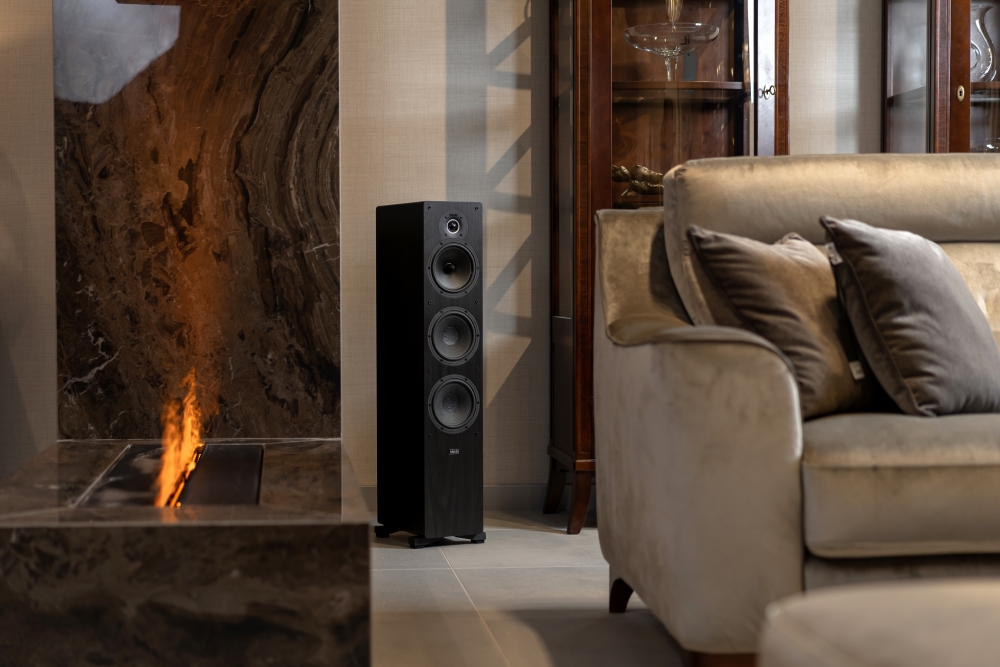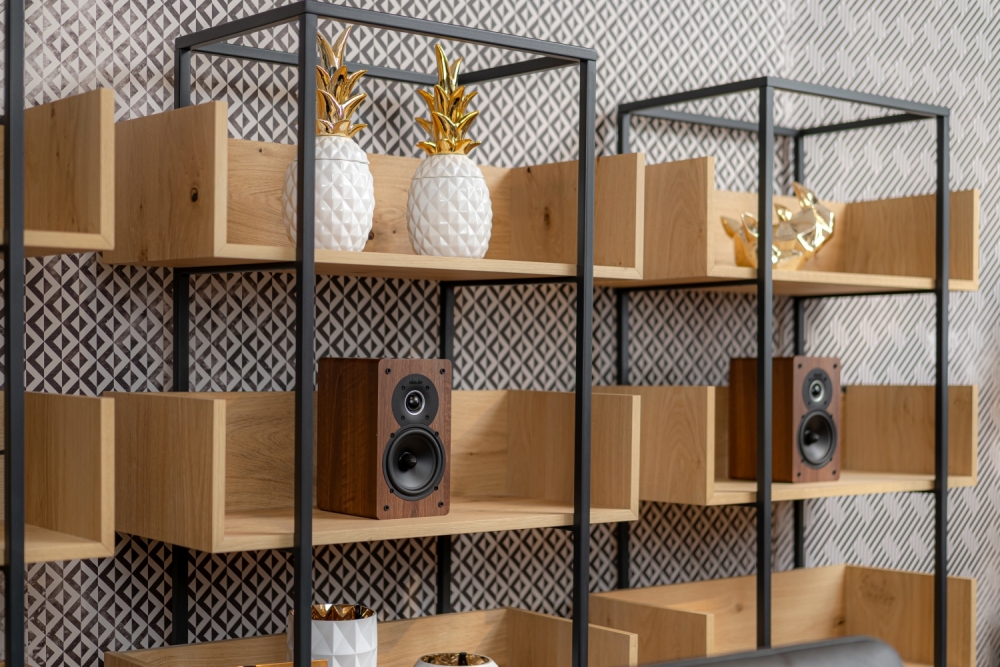Speakers placement – how to position the speakers in the room?
One of the key elements influencing the sound quality is not only the right choice of loudspeakers, but also their proper placement. We advise on what to pay attention to and how to properly position Indiana Line speakers.
How to set the speakers ? – contents

How to set the speakers 5.1 – speakers placement 5.1 in the room
The placement of the speakers 5.1 in the room is of great importance in terms of sound. It is worth making sure that the individual speakers in the home theater system are placed at an equal distance from the viewer. Another important aspect will be the appropriate orientation of the speakers directly towards the watcher.

In practice, it looks like there are three speakers at the front – a pair of main speakers and a center speaker – at the back there are two surround speakers and a subwoofer, the correct placement of which will translate into the satisfaction of the listener with the sound of bass.
So let’s take a look at what the correct placement of the speakers 5.1 in the room looks like.
Front speakers placement
The front, which consists of the left and right channel – composed of any Indiana Line floorstanding speakers or larger bookshelf models, e.g. Indiana Line Diva 262 – and the central speaker, such as the Indiana Line Diva 752, plays the most important role when placing the speakers in the home theater systems. Their task is to create a wide sound stage in the listening room, complement dialogues and guide the viewer during the events happening on the screen.

The side speakers should be placed at a mutual distance, approximately equal to the distance from the listener, and at equal distances from the TV set, which is not always possible. If, for example, we are limited by the listening room, which makes it difficult to maintain a proportional distance, nothing is lost.
Slight differences can be corrected by the receiver with the included calibration microphone, which will examine the acoustics of our room and determine the distances of the speakers from the listening position, while minimizing the disproportions resulting from the uneven arrangement of the speakers.
How to set the central speaker
The central speaker, as the name suggests, should be placed in the center, directly below or above the TV set. It is responsible for the dialogues and the voice of the lector, therefore its correct positioning is extremely important.

Moving the central speaker to the side would lead to unpleasant sonic surprises and the effect of incoherence. For example, we would see the actor in the middle and his line would come from the left or right.
So it’s worth spending time choosing the right model, for example Diva 752 or Indiana Line Tesi 761, and then setting the speaker properly. Thanks to this, we will be sure that the dialogues will be perfectly audible and there will be no need to turn up the volume too much to hear what the actors said. It also has an impact on the proper construction of the sound stage.
How to set the surround speakers
An important element of the home theater system are also the surround speakers located most often behind our main listening place. Their task is to transmit sounds such as, for example, the flight of an airplane or background noises. This increases the sense of being surrounded by sound and completes the structure of a multi-channel cinema panorama.
As in the case of the front speakers, the surround speakers should be placed at an equal distance from each other, which will translate into the proper reception of the played music. It is also good to ensure that the surround speakers are not directly behind the viewers and are directed towards them. Indiana Line bookshelf speakers, such as the Diva 262, Indiana Line Nota 260 X or the smaller Indiana Line Tesi 241 or Indiana Line Nota 240 X, will be perfect for the surround speakers.
How to set the subwoofer

In a home theater system, a subwoofer will be the best to process the bass band, such as the Indiana Line Basso 880 or the smaller Indiana Line Basso 840 model. How to set it up in a 5.1 system? There are several possibilities and they depend on what we want to get:
1) If we primarily want a lot of bass – at the expense of precision – then we can place the subwoofer in one of the corners of the listening room.
2) If we want a lot of bass that will be relatively accurate, you can place the subwoofer close to one of the side walls.
3) If the goal is to achieve the most precise – although a bit weaker – bass, it is worth placing the subwoofer close to the listening position, e.g. directly behind a couch or armchair. Thereby, the proportion of the direct pressure of the bass in relation to its resonances coming from the room is increased, thanks to which the bass becomes closer.
The latter option will seem to be the best one if we have the opportunity to do so. In this way, we will be sure that a properly set subwoofer will fantastically complement the sound of the loudspeakers with its potential in the lowest, difficult to process acoustic frequency range.
The appropriate subwoofer configuration may also be helpful. Proper adjustment – setting a lower crossover frequency so that the device has as little work as possible – will make the quality of the background music closer to what we know from high-quality music systems. Such a procedure facilitates and improves the acoustic integration of the bass unit with the rest of the system, but shifts the burden of responsibility to the front speakers. So in such a situation it is worth taking care of high-quality front speakers, for example Indiana Line Tesi 661, Indiana Line Tesi 561 or Indiana Line Diva 662.
How to set the speakers in a small room
The main aspect influencing how our audio system sounds is the correct placement of the loudspeakers. Not only the distance to the walls plays an important role, but also the angle at which they are positioned, which results from the nature of the membrane’s operation.

A working loudspeaker vibrates the air in front of it. Since its membrane diameter and cabinet width are usually comparable to or greater than the processed wavelength, the loudspeaker starts to behave more like a sonic “searchlight” than a room lamp and sends most of the sound forward rather than to the sides.
If we want to improve the area of the sound stage, we can place the speakers perfectly straight ahead. Such a procedure will increase the proportion of diffused and reflected sound from the side walls in relation to that which reaches the listener’s ears directly from the loudspeakers. The sound stage clearly “grows”, but this is done at the cost of slightly blurring the location of the instruments.
For fans of greater sound intimacy, a better solution will be to direct the speakers inwards, so that the main axes intersect right in front of the listener. This allows the sound to concentrate directly near the listener, focusing the soundstage closer to the center, while improving the precision of the location of phantom sound sources.
How to set the stereo speakers
Theoretically intuitive thing, which is the correct placement of the loudspeakers, can be quite a challenge. Therefore, it is worth taking care of a few basic elements, e.g. keeping a minimum distance from the walls (especially in case of the bass reflex cabinet with a rear firing port) and between the two speakers (about 1,7 meters). We should also avoid placing the speaker units in the corners of a room.

Moreover, we should place the loudspeakers at the correct height so that the position of the tweeter is at the level of the listener’s ear. Another important factor is ensuring that individual speakers are located at a proportional distance from the walls and work in a similar environment, e.g. along the same wall or under one window.
It is difficult for the listening room to be acoustically arranged, therefore listening to music will be accompanied by reverberation depending on other furniture and objects in the room. In order to reduce reflections to a minimum, you can equip you interior with curtains to subtly dampen the side walls, and place a small carpet in front of the speakers that will help the lowest frequencies spread properly.
The best solution, however, will be to equip yourself with shelves or shelves filled with books, and preferably music CDs. Numerous recesses in shelves, together with properly selected contents, do not so much absorb, but disperse the sound evenly throughout the room. It is extremely desirable in terms of creating a wide soundstage with natural sounding instruments. This procedure will affect any reverberation or even an echo present in an empty room even more effectively than, for example, damping the sound with curtains.
The mentioned elements of room acoustics also contribute to well-sounding audio equipment. If you have additional questions, please visit one of the authorized Indiana Line loudspeakers showrooms, where our experts will help you choose the right speakers.
